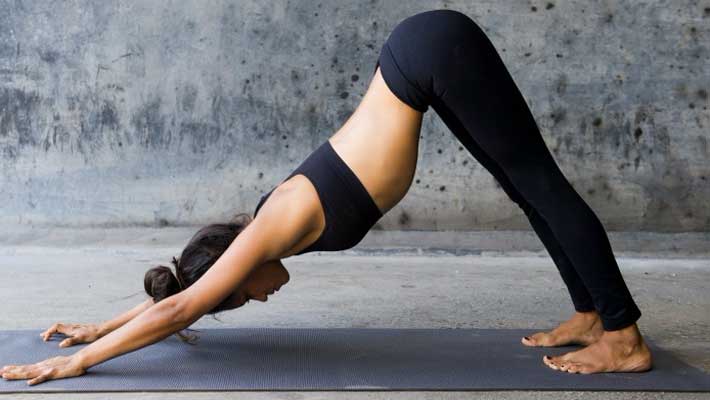
Ashtanga Vinyasa is a dynamic style of yoga, where a progressive series of asanas and bandhas are practiced while synchronizing with breath and point of focus, which results in complete detoxification of the body.
Sri Pattabhi Jois is credited with the development of the Ashtanga Vinyasa structure and practice in its current form. It is believed that the method has been passed on from the ancient Saint Vamana in his text called ‘Yoga Korunta’. In the 1920s Sri T Krishnamacharya transcribed the Yoga Korunta and passed on his teachings to the late Pattabhi Jois. Sri Pattabhi Jois’ school in Mysore under the aegis of his grandson Sharat Jois continues to teach this method.
Ashtanga means ‘8 limbs’, which signifies the 8 limbs of yoga as per Patanjali’s Yoga Sutras. Vinyasa is understood in this context as linking breath and movement. Nyasa means ‘to place’ and vi denotes ‘in a special way’.
The eight limbs of yoga are Yama (moral code), Niyama (spiritual self purification), Asana (postures), Pranayama (breath control), Pratyahara (sensory transcendence), Dharana (concentration), Dhyana (meditation), Samadhi (union or state of ecstasy). The style of yoga advocates that the teacher and practitioner practice all these eight limbs of yoga on and off the mat.
The purpose of Vinyasa is internal cleansing. Vinyasa combines asana practice with breath and drishti (point of looking), in conjunction with each other to attain three levels of purification: body, nervous system and mind.
A student of Ashtanga Vinyasa starts with Suryanamaskar A with 9 movements, Suryanamaskar B with 17 movements. Suryanamaskar A is the preparatory sequence where more asanas are added to form Suryanamaskar B. In Ashtanga style one cycle incorporates both the right and left sides, as against the 12 step suryanamaskar of the Shivananda School where the 12 asanas are repeated on each side. Ashtanga incorporates an overall structure similar to Shivananda style for movement of the spine and energizing the solar plexus, while changing some asanas like : Veerabhadra 1 (Warrior1), instead of Aswha Sanchalana (equestrian), chaturanga dandasana (low plank) instead of ashtanga namaskar (knee-chest-chin down), Urdhwa mukha shwana (upward facing dog) instead of bhujangasana (cobra), and additionally incorporating Uthanasana B (Half forward bend) and Utkatasana (chair pose) in the Suryanamaskar B.
Following this the student needs to master the Primary Series or Yoga chikitsa series. This comprises of groups of standing, sitting and finishing asanas, and together they rid the body of illnesses. This is followed by Secondary Series of asanas called the nadi shodhana or the nerve purifiers. The final set is the difficult Advanced Series that play with gravity, for sthira bhaga or centering of strength in order to reach sublime serenity.
Ashtanga Vinyasa provides a structure for practice, and in a typical class one does not deviate from this structure. They start with the suryanamaskars and end with padmasana and rest. The asanas gradually fill the space between these two. The teacher provides proper guidance at an individual level, and ensures that the asana alignment and breath are correct before moving to the next one. Students practice by themselves in the prescribed structure while the teachers observe. The guided classes led by teachers are also interspersed routinely.
According to the gurus, anyone can practice Ashtanga Vinyasa Yoga irrespective of age, gender or sickness as long as it is taught at a pace suitable to the individual by a knowledgeable teacher. At its core it is fundamentally a breathing practice, alongside asanas. It is a progressive practice and asanas are offered as the student becomes ready. Saving any serious illness or injury, the student works though the sequence one after another. With awareness of the counter indications for every asana one can master limitations and physical blocks, thereby unraveling the Self.
The movement of the body along with breath, heats up the blood and helps it circulate freely, taking away pain. The sweat produced as a result removes toxins from the body, thereby building health and strength. Breathing is held steady during rechaka (inhalation) and puraka (exhalation) alongside the asana, in order to purify the nervous system. Drishti or point of focus, stabilizes the functioning of the mind. The air and fire element are considered two important factors for cleansing the body. The fire element is at the abdominal region and considered the standing place of our life force. The breathing is then the air element that stokes the fire evenly to control the internal fire to aid in purification and stabilize the autonomous nervous system.
The mula and the uddiyana bandhas form an integral part of the breathing process. They are the anal lock and the lower abdominal lock that help seal energy and give health and strength to the body. For complete benefit of the asanas and building an automatic mind control, these bandhas need to be practiced.
Ashtanga Vinyasa hence provides a strong foundation for higher practices of pratyahara, dharana, dhyana, samadhi as prescribed in the yoga sutras.
